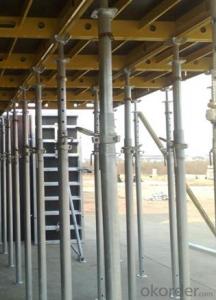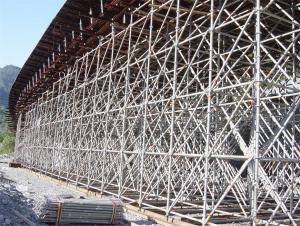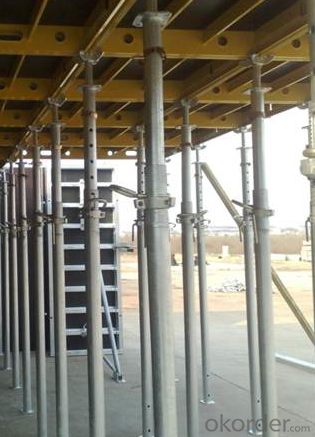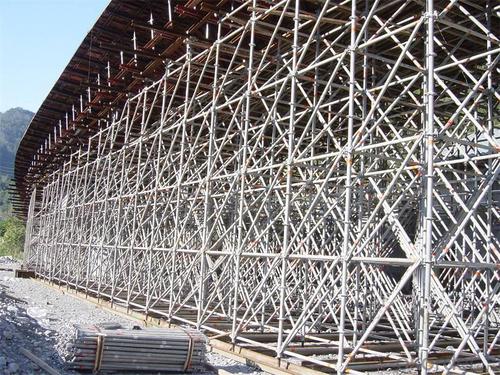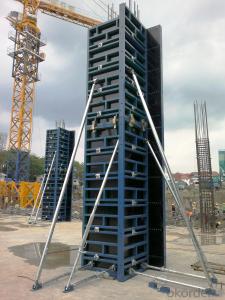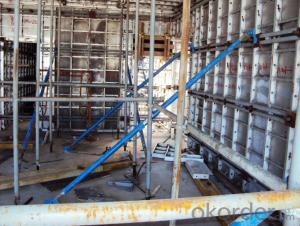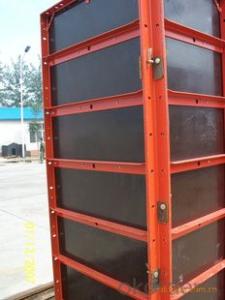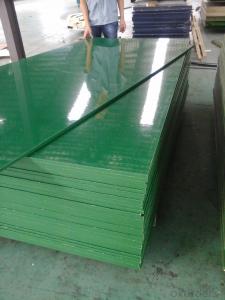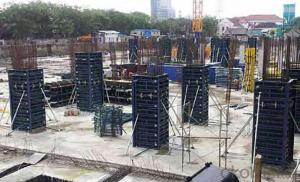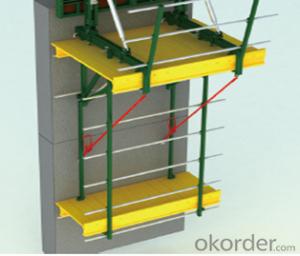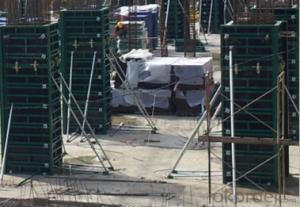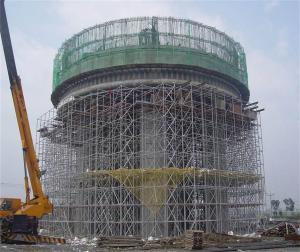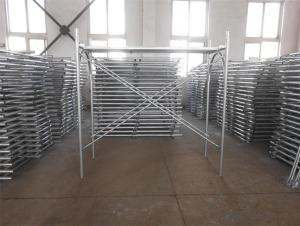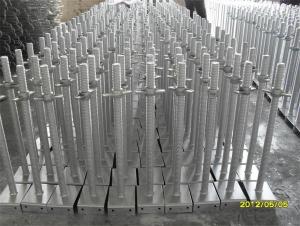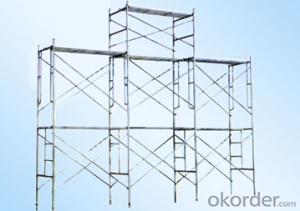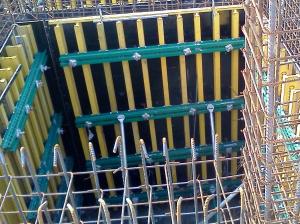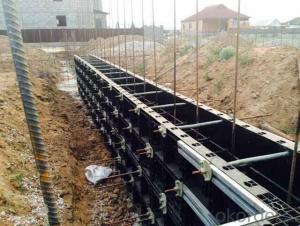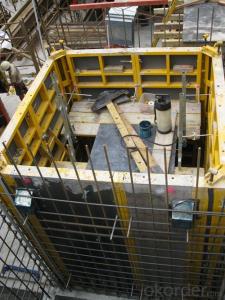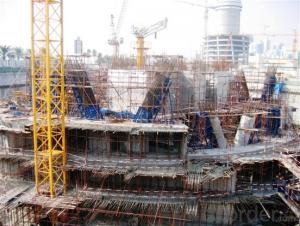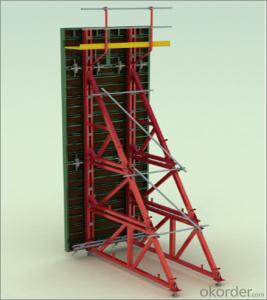Ring-Lock Scaffolding ,Tower Scaffolding with Hot or Cold Galvanized Surface
- Loading Port:
- Shanghai
- Payment Terms:
- TT OR LC
- Min Order Qty:
- 1000 m²
- Supply Capability:
- 100000 m²/month
OKorder Service Pledge
OKorder Financial Service
You Might Also Like
1.Structure of Ring lock Description
Ringlock Scaffolding system is the most popular used Scaffolding system in the world.It will greatly reduce the cost because of the following advantages
Packaging & Delivery
Packaging Details:
Pallet or bag or upon client's request
Delivery Detail:
35days
2.Main Features of Ringlock
It will greatly reduce the cost because of the following advantages
1)Using less pipes
2)Easy to install
3)It can be used again and again for nearly 20years
3.Ring lock product pictures:
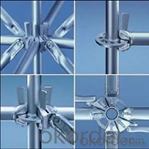
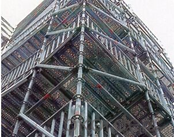
4.Ringlock Product Description
Type: ringlock scaffolding diagonal Brace
specification : Ø48.3×3.20
material:: steel Q235
Finished: Hot DIP galvanized, painted
Diagonal length(m) :Weight(kg)
0.9m * 1.25m 6.28
1.25m * 2.7m 11.45
5.FAQ
We have organized several common questions for our clients,may help you sincerely:
1)How about your company?
CNBM International Corporation, China National Building Materials (Group) Corporation, is one of the largest companies in China building material equipment industry, Our formwork and scaffolding are largely used in both domestic and all over world;
2)How many Scaffolding your company have?
Here comes our 5 types of Scaffolding systems:
- Cup lock Scaffolding(C-Lock Scaffolding)
- Ring lock Scaffolding
-Kwistage Scaffolding
-H-frame Scaffolding
-ID15 Scaffolding Tower, this type Scaffolding is the most widely used in construction, such like bridge.
3)How long can we receive the product after purchase?
Lead time is about 30days after getting the signed PI and deposit.
- Q: Can steel frame formwork be used for both interior and exterior concrete elements?
- Yes, steel frame formwork can be used for both interior and exterior concrete elements. Steel frame formwork provides excellent strength and durability, making it suitable for various construction applications. It can effectively hold the weight and pressure of concrete, ensuring a smooth and efficient construction process for both interior and exterior concrete elements.
- Q: Can steel frame formwork be used for both conventional and lightweight concrete?
- Steel frame formwork is capable of being used for both conventional and lightweight concrete applications. Its versatility and durability make it a suitable choice for a wide variety of concrete projects. Whether it involves traditional aggregates and cement or lightweight aggregates like expanded clay, shale, or slate, steel frame formwork offers the necessary support and structure during the concrete pouring and curing stages. Its strength and stability enable it to handle the weight and pressure exerted by both conventional and lightweight concrete, ensuring that the desired shape and design of the concrete structure are successfully achieved.
- Q: Can steel frame formwork be used in projects with limited construction site security or theft risks?
- Yes, steel frame formwork can be used in projects with limited construction site security or theft risks. Steel formwork is sturdy and durable, making it less susceptible to theft or damage compared to other types of formwork materials. Its robust construction provides added protection against unauthorized access or tampering, making it a suitable choice for projects with limited security measures in place.
- Q: How does steel frame formwork handle the placement of architectural features and details within the concrete structure?
- Steel frame formwork provides a versatile and efficient solution for handling the placement of architectural features and details within a concrete structure. With its sturdy and rigid structure, steel frame formwork ensures the accuracy and precision required to incorporate various architectural elements seamlessly into the concrete design. One of the key advantages of steel frame formwork is its ability to mold and shape concrete according to the desired architectural features. The steel frames can be easily customized to accommodate different shapes, curves, and angles, allowing for the creation of intricate architectural details. This flexibility allows architects to unleash their creativity and bring their unique designs to life. Moreover, steel frame formwork provides excellent support and reinforcement for architectural features during the concrete pouring process. The strong steel frames create a stable structure that prevents any deformation or displacement of the architectural elements. This ensures that the features are accurately positioned and securely embedded within the concrete structure, minimizing the risk of future damage or deterioration. The precision and accuracy of steel frame formwork also contribute to the overall quality and aesthetics of the concrete structure. By providing a reliable and stable framework, the formwork enables the concrete to be poured with great precision, resulting in a smooth and uniform finish. This ensures that the architectural features are well-defined and visually appealing, enhancing the overall beauty and appeal of the structure. Additionally, steel frame formwork offers time and cost-saving benefits when it comes to incorporating architectural features. The modular nature of the steel frames allows for easy assembly and disassembly, reducing construction time and labor costs. This, in turn, facilitates the efficient placement of architectural details within the concrete structure. In conclusion, steel frame formwork plays a crucial role in handling the placement of architectural features and details within a concrete structure. Its versatility, strength, and precision allow for the seamless integration of various architectural elements, ensuring the creation of visually stunning and structurally sound concrete designs.
- Q: What are the key considerations for selecting the appropriate steel frame formwork system for projects with limited construction budgets?
- When selecting a steel frame formwork system for projects with limited construction budgets, there are several key considerations to keep in mind. Firstly, it is important to evaluate the cost-effectiveness of the system. This includes assessing the initial cost of the formwork, as well as any additional expenses such as transportation, installation, and maintenance. Secondly, the durability and lifespan of the system should be considered to ensure it can withstand the demands of the project without requiring frequent repairs or replacements. Additionally, the versatility and adaptability of the formwork system should be taken into account, as it should be able to accommodate various types of structures and design requirements. Lastly, the availability and accessibility of the system should be considered, as it should be easily procurable within the limited budget and readily available for use. By considering these factors, one can select an appropriate steel frame formwork system that meets both the budgetary constraints and construction needs of the project.
- Q: Can steel frame formwork be used for both flat and sloped slab construction?
- Yes, steel frame formwork can be used for both flat and sloped slab construction. Steel frame formwork provides a robust and durable solution for creating the necessary mold or framework for pouring concrete. It can be easily adjusted to accommodate different slab angles and configurations, making it suitable for both flat and sloped slabs. The steel frame formwork system allows for precise alignment and provides a strong support structure, ensuring that the concrete slab is poured accurately and securely. Additionally, the steel frame formwork can be reused multiple times, making it a cost-effective choice for both flat and sloped slab construction projects.
- Q: How does steel frame formwork help in achieving accurate concrete leveling?
- Achieving precise concrete leveling is made possible with the use of steel frame formwork, as it offers a rigid and stable structure for pouring and shaping the concrete. Designed to be strong and durable, the steel frames maintain their shape and alignment throughout the entire pouring process. One major advantage of steel frame formwork is the ability to have precise control over the concrete placement and leveling. The frames can be easily adjusted and aligned to the desired height and slope, ensuring accurate pouring. This eliminates any inconsistencies or unevenness in the final concrete surface. Furthermore, steel frame formwork provides exceptional support and stability, preventing any deformation or movement during the pouring and curing of the concrete. This guarantees that the concrete maintains its intended shape and level, even under the pressure of the wet mix and its own weight. Additionally, the steel frames minimize the risk of concrete shrinkage and settlement, which can occur if the formwork is not adequately supported. By providing a strong and rigid structure, the frames distribute the weight of the concrete evenly, reducing the chances of sinking or settling after curing. Moreover, steel frame formwork is highly adaptable and can be easily customized to fit various shapes and sizes of concrete structures. This allows for accurate leveling, even in complex and irregular designs. In conclusion, steel frame formwork is essential in achieving accurate concrete leveling by offering a stable and adjustable structure for pouring and shaping. Its strength, stability, and versatility ensure that the concrete maintains its desired level and shape, resulting in a high-quality and level finished surface.
- Q: How does steel frame formwork handle different concrete loads?
- Steel frame formwork is specifically designed to handle different concrete loads by providing a strong and durable structure. The steel frames are capable of withstanding heavy loads and distributing them evenly throughout the formwork system. Additionally, the adjustable features of steel frame formwork allow for customization and adaptation to various concrete loads, ensuring the stability and integrity of the structure during the pouring and curing process.
- Q: Can steel frame formwork be used for the construction of religious buildings?
- Yes, steel frame formwork can be used for the construction of religious buildings. Steel frame formwork is a versatile and durable construction technique that allows for the creation of complex shapes and structures. Religious buildings often have unique and intricate designs, and steel frame formwork can easily accommodate these requirements. Additionally, steel frame formwork offers a high level of strength and stability, which is crucial for the construction of religious buildings that are often large and iconic structures. Moreover, steel is a sustainable and environmentally friendly material, making it a suitable choice for religious buildings that often prioritize sustainability and environmental consciousness. Overall, steel frame formwork is a viable option for the construction of religious buildings and can provide the necessary structural integrity and aesthetic appeal required for such projects.
- Q: Can steel frame formwork be used for heavy-duty industrial structures?
- Yes, steel frame formwork can be used for heavy-duty industrial structures. Steel is a durable and strong material that can withstand the heavy loads and pressures associated with industrial construction. It provides stability, stiffness, and resistance against deformation, making it suitable for constructing large and robust structures. Additionally, steel frame formwork allows for flexibility and adaptability in the construction process, making it an ideal choice for heavy-duty industrial projects.
Send your message to us
Ring-Lock Scaffolding ,Tower Scaffolding with Hot or Cold Galvanized Surface
- Loading Port:
- Shanghai
- Payment Terms:
- TT OR LC
- Min Order Qty:
- 1000 m²
- Supply Capability:
- 100000 m²/month
OKorder Service Pledge
OKorder Financial Service
Similar products
Hot products
Hot Searches
